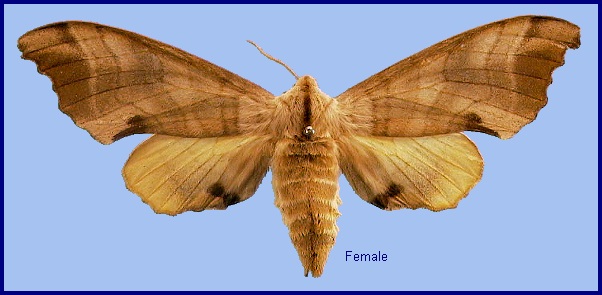
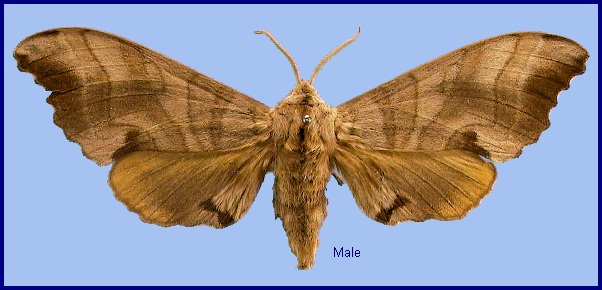
Smerinthus maackii Bremer, 1861, Bull. Acad. imp. Sci. St Pétersb. 3: 474. Type locality: [Russia, Primorskiy Krai], between the Noor [He (in China)] and Ema[/Iman/Bolshaya Ussurka] rivers.
Synonym. Smerinthus maackii Bremer, 1861.
Synonym. Marumba maackii bipunctata O. Bang-Haas, 1936.
Synonym. Marumba maackii jankowskioides O. Bang-Haas, 1936.
Wingspan: 78--96mm. Distinguished from all other Marumba by the buff-yellow colour of the costal and distal margins of the hindwing upperside; tornus with two spots touching so forming an 8-shaped marking, rarely separated. The forewings are mainly various shades of grey in fresh individuals, with the hindwings being grey and yellow. This fades to various shades of brown and buff in museum specimens.
In the male genitalia, uncus narrow as in Marumba amboinicus, deeply divided, lobes ladle-shaped, close together rendering sinus narrow. Gnathos with medial process bell-shaped. Valva with dorso-apical lobe not always sharply pointed, shorter than in M. dyras, more closely resembling that of Marumba quercus; processes of subdorsal basal fold short, acute, prismatic and granulose. In the female genitalia, proximal part of sterigma transverse, rounded proximally, sides raised into a short cone, edge in front of ostium truncate, feebly undulate.
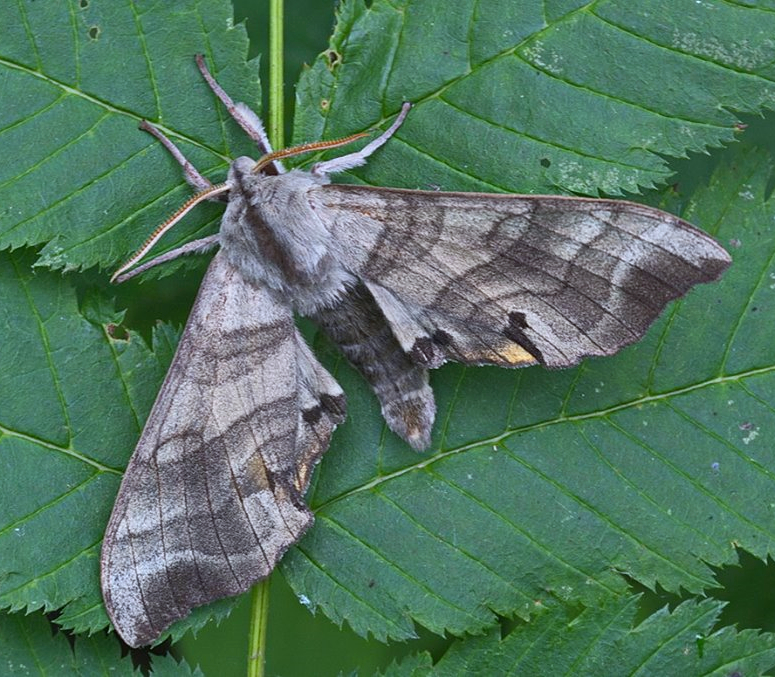
A montane species in Korea. In the Russian Far East associated with mixed conifer-deciduous forests and pure deciduous woodland characterized by Quercus mongolica (Izerskiy, 1999b).
China: 1.vi (Shaanxi); vi-vii (Nei Mongol; Heilongjiang; Beijing). North Korea: vi (Sinmi-do; Muhak-san, Kilju City). South Korea: 20-28.vi (Ulleung-do). Japan: vii (Hokkaido). Russia: 27.v (Primorskiy Krai); 9-18.vi (Primorskiy Krai); 19.vi-19.vii (Khabarovskiy Krai); vii (Yevreyskaya; Primorskiy Krai); 7-14.vii (Khabarovskiy Krai); 10-26.vii (Primorskiy Krai); 4-6.viii (Primorskiy Krai).
Izerskiy (1999b) states that this species is mainly single brooded in the Russian Far East, from June until late July. However, in warm years there is a partial second brood, with adults in May/June and in August.
Park et al. (1999) give July and August as the flight period in Korea.
OVUM: Translucent pale yellow. Oval (2.00 x 1.5mm), shiny and smooth. With development, the brown mandibles of the larvae become visible. Many eggs collapse partially at this stage, giving the impression of being infertile.
LARVA: Full-fed 70mm. Trimorphic: greyish-green, yellowish-green or, sometimes, reddish.
The newly hatched, 6mm-long larvae are a uniform pale yellow and of equal thickness from a spherical head to a straight yellow horn. The mandibles are brown.
In the second instar still pale yellow, but with a greenish tinge developing. The body is elongate, tapers frontad, is strongly counter-shaded, and is covered in fine yellow tubercles, even the head and horn. Yellow oblique lateral stripes appear with growth. Head vertex pointed. Upper two-thirds of now reddish-orange horn darker. Final size: 14mm.
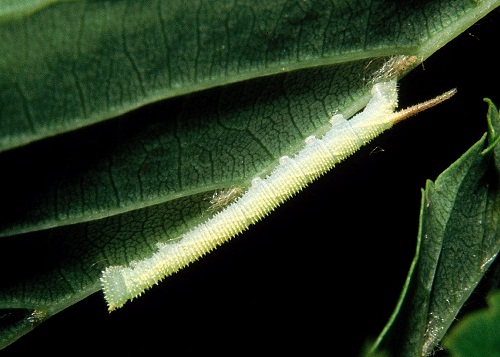
The third instar is very similar to the second, but the body becomes more peppermint green dorsally and grey-green ventrally, the head more pointed and tipped with orange, the horn dusted with black dorsally. Final size: 20mm.
The fourth instar looks similar to the third, but with more pronounced markings. The dorsal surface of the body, which tapers frontad, is yellowish green with fine, sharply pointed, lemon yellow tubercles; the oblique lateral strips are of the same colour. The ventral surface is greyish-green with pale yellow tubercles. The head is more pointed with a double vertex. Horn mainly pale yellow with an orange tint, darker dorsally. Final size: 26mm.
The fifth instar resembles the fourth, but the markings are even more pronounced. Ventral surface of body becoming whitish. The oblique side stripes with sharp, conical tubercles in the form of a ridge. Last oblique stripe bold, merging with the now yellow horn. Latter has some grey along the lower dorsal surface. True legs yellow, becoming pinkish at tips. Spiracles pale yellow. Final size: 44mm.
The sixth and final instar basically pale yellowish-green (with lemon yellow tubercles and stripes) in some, greyish-green (with pale yellow tubercles and stripes) in others, both forms tending to whitish ventrally. In the yellowish-green form, the oblique lateral stripes may be edged with carmine red frontad. Whole body, head and horn covered with many fine tubercles, giving the larva a 'sandpaper-like' texture; however, many of the ventro-lateral tubercles are larger, ringed with grey at their base. Head triangular with pale yellow cheek stripes; vertex no longer pointed. Horn straight, heavily tubercled, pale orange-yellow or pale yellow. True legs carmine red with some yellow edging. Feet of claspers brownish or reddish, that of the anal clasper more so and edged with yellow above foot. Spiracles black with a white vertical bar centrally.
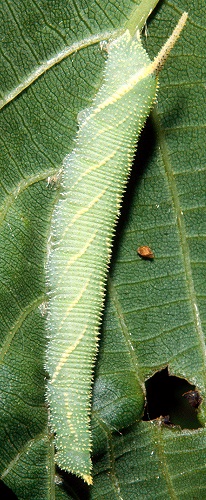
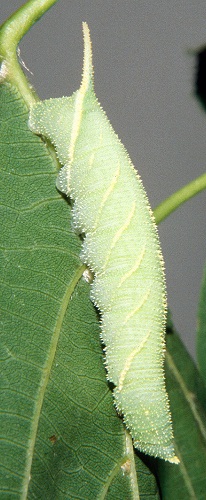
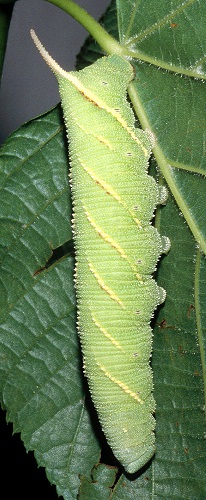
Newly emerged larvae ignore the eggshell and wander around for some time before settling down under a leaf to feed for one or two days, nibbling at the leaf edge. This is followed by the first skin change. In the second instar, rests along a vein on the underside of a leaf, often with the anterior two-thirds of the body raised and curved around in the form of a question mark. As the larva increases in size it starts to hang head down, often only hanging on by the last two pairs of claspers. In the final instar it is often too large to hide completely under a leaf and may hang from the petiole.
PUPA: 40--45mm. Very dark brown and glossy; tapering caudad from a blunt head and thorax. Head tuberculate, with a blunt, broad crest frontad. Proboscis not present, but replaced by a knob-like tubercle. Wings smooth, abdominal segments finely punctate. Cremaster broadly conical, with a sharp point; tuberculate. Similar to that of Smerinthus ocellata, but head more rough and with two crest-like tubercles frontad, as found in most species of Marumba. Formed in an almost silk-free cell in the soil. The overwintering stage.
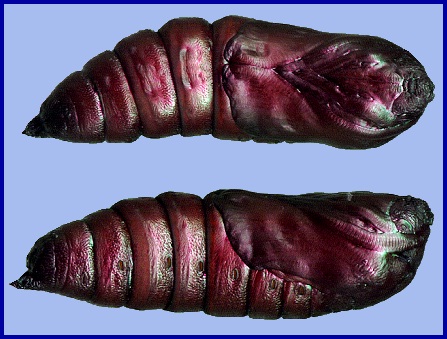
Larval hostplants. Recorded in Primorskiy Krai, Russia, on Tilia (Derzhavets, 1984), particularly Tilia amurensis (Izerskiy, 1999b).
In captivity will feed on almost any european species of Tilia, including Tilia cordata, Tilia platyphyllos and Tilia tomentosa, and hybrids thereof.
Ichneumonidae: Amblyjoppa cognatoria (Smith, 1874), Amblyjoppa proteus satanas (Kriechbaumer, 1895).
China: Nei Mongol (Zalantun/Butha Qi; Chifeng/Ulanhad, Daguangdingzishan, 2061m; Hulunbuir Region, Sanhaodian); Heilongjiang (Zhaodong; ??Ertzendziandzi; Dailing); Liaoning (Changhai, Dachangshan Island); Beijing (Baihua Shan; Badaling National Forest Park); Shanxi (Yanggao County, Dadengshan); Shaanxi (Qinling, Ankang (Amaël Borzée, iNaturalist 2024); Taibai Shan, Heihe National Forest Park, Houzhenzi).
North Korea: North Pyongan Province (Sinmi-do); North Hamgyong Province (Jueul; Chongjin; Muhak-san, Kilju City); South Hamgyong Province (Pulgaemi ridge above Pukchong City, 1500m).
South Korea: Kyonggi Province (Chukryong-san); Kangwon Province (Gwangduk-san; Seolak-san; Woljeong Temple; Taebek-san; Gyebang-san; Jungseon); North Chungchong Province (Wolak-san); North Cholla Province (Jiri-san; Namwon); South Cholla Province (Baekyang Temple; Gurye; Younggwang); North Kyongsang Province (Gunwi; Cheongdo; Ulleung-do); South Kyongsang Province (Geoje-san; Goseong; Sacheon; Namhae; Sancheong; Hadong; Hamyang; Hapcheon); Cheju Province (Sungpanak; Gwaneum Temple).
Japan: Hokkaido (Sapporo).
Russia: Amurskaya (Uril area; Blagoveshchensk); Yevreyskaya (Pompeyevka; Radde; Bastak Nature Reserve); Khabarovskiy Krai (Bolshekhekhtsyrskii nature reserve, Khabarovsk suburbs; Bojcovo; Slavyanka; Lidoga; Pivan); Primorskiy Krai (Kaymanovka; Primorskiy; Khasan; Vladivostok; Narva; Novoselskiy, Lake Chanka; Novovladimirovka; Kedrovaya Pad Nature Reserve; Vityaz Bay; near Zanadvorovka; Kravtsovka; Anisimovka).
Russian Far East, northeastern China, North Korea, South Korea and northern Japan (Hokkaido). [The individuals of Marumba maackii ochreata Mell, 1935 recorded from Yunnan may turn out to be this taxon once barcodes are analysed, with populations extending south along the foothills of the Tibetan Plateau in a manner similar to Laothoe amurensis sinica (Rothschild & Jordan, 1903).]
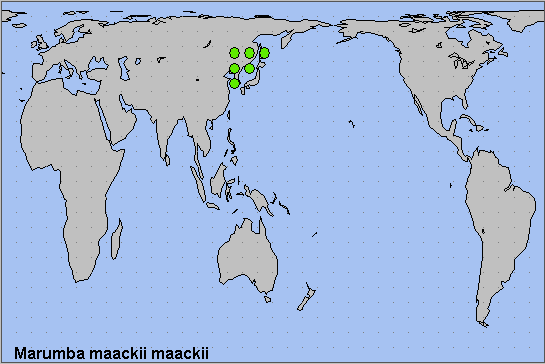
 Return to Sphingidae of the Eastern Palaearctic species list
Return to Sphingidae of the Eastern Palaearctic species list